#Microsoft Power pages
Explore tagged Tumblr posts
Text
Become a Power Pages Pro | A Comprehensive Guide to Building Your Business Website
If you’re a business owner, you know a website is essential to success. A website not only helps you establish an online presence, but it can also help you connect with potential customers and grow your brand. But creating a website from scratch can be intimidating, especially if you need to become more familiar with web design and development.
That’s where becoming a Power Pages Pro comes in. With this comprehensive guide, you’ll learn everything you need to know to build a professional, effective website for your business. From choosing the right platform and design to optimizing your site for search engines and improving the user experience, this guide covers all the essential elements of creating a successful website.
Whether you’re just starting or looking to improve your existing site, this guide will give you the knowledge and skills you need to become a Power Pages Pro and take your online presence to the next level. So, let’s get started and build a website that will help you achieve your business goals!
#power platform services in las vegas#Microsoft Power Pages#Power Pages Consulting#Power Pages#it consulting in las vegas#managed service provider#managed it services
1 note
·
View note
Text
Knowledge is Power with Microsoft Power Platform Solutions
The Power Platform is a suite of tools developed by Microsoft to empower organisations to analyse data, build solutions, automate processes, and create virtual agents.
Our team of experienced and insightful developers work in partnership with you to build capabilities, transform and future-proof business.
With Microsoft Power Platform you are able to make actionable decisions at the right time for your business.
The platform provides your organisational with cloud-based solution development and pre-built templates, hundreds of out-of-the-box connectors with drag-and-drop simplicity, removing the months and costs of labour intensive development.
When customisation is required, you can extend solution capabilities without limits with customisable components when you need them.
Each component of the Microsoft Power Platform is dynamic on its own, but intelligent and masterful when used together.
The team at Sognos has right knowledge and capabilities expand through the breadth and depth of Microsoft’s Power Platform including niche expertise in developing solutions & providing digital strategy leveraging PowerApps, Power BI, Power Automate, Power Pages, and CoPilot.
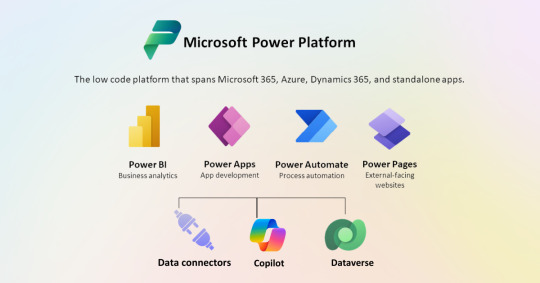
#Microsoft Power Platform Solutions#Power Platform Solutions#Microsoft Power Platform#Power Platform#Power BI#Microsoft Power Pages#CoPilot#cloud-based solution
0 notes
Text
#dynamics 365 portal#dynamics partner portal#microsoft dynamics portal#microsoft portals#microsoft power apps portals#microsoft power pages#microsoft power portal#power pages#power pages microsoft#power pages power bi#power pages sharepoint
1 note
·
View note
Text

Unlock the Power of Your Data: 7 Secrets Microsoft Power BI Consultants Don’t Want You to Know
Have you ever felt like you're sitting on a goldmine of data, but all you have is a rusty shovel and a faded map? That's the reality for many businesses today. They're swimming in information, yet struggle to extract the insights that could propel them forward. Microsoft Power BI offers the promise of transforming raw numbers into actionable intelligence. But what if we told you there are some hidden strategies, the kind that often remain locked away within the toolkits of seasoned consultants?
7 Secrets Microsoft Power BI Consultants Don’t Want You to Know
1. The Art of the Data Model: It’s More Than Just Connecting Tables
2. Embrace DAX Like a Native Speaker
3. Storytelling Over Graphs: Crafting Compelling Narratives
4. Performance Optimization: The Devil is in the Details
5. Power Query: Your Secret Weapon for Data Munging
6. Go Beyond the Dashboard: Interactive Exploration
7. The Power of Community: Never Stop Learning
This isn't about throwing shade at the excellent work Microsoft Power BI consultants do—rather, it’s about empowering you to take control and maximize your Power BI investment. Here are 7 secrets they might not explicitly spell out, designed to help you unlock the full potential of your data:
1. The Art of the Data Model: It’s More Than Just Connecting Tables
Many users focus solely on creating visualizations, neglecting the backbone of any great Power BI report: the data model. A poorly structured model, while seemingly functional at first, can lead to performance issues, inaccurate calculations, and general frustration down the line. Secret: spend ample time designing your model carefully, understand your relationships, and think about the most efficient way to join your tables. Learn how to leverage DAX functions like CALCULATE properly for optimized measures.
2. Embrace DAX Like a Native Speaker
DAX (Data Analysis Expressions) is the language of Power BI, and while many beginner tutorials cover the basics, true mastery is required to unlock advanced analysis. Don’t just rely on the built-in calculation tools. Secret: invest in learning DAX properly. Understand context, filter propagation, and the power of functions like FILTER, ALL, and EARLIER. This will dramatically improve the performance of your reports and allow you to perform more complex analysis.
3. Storytelling Over Graphs: Crafting Compelling Narratives
Visualizations are powerful, but ultimately, they are just tools to communicate insights. The goal shouldn't be about creating the most visually stimulating chart, but about crafting a cohesive data story. Secret: before building reports, think about the main messages you want to convey. Guide the reader through your data. Think of your reports as a visual presentation that unfolds a story. Don't just throw graphs onto a page; create a flow. Consider using tooltips and drill downs to add detail without overwhelming the user.
4. Performance Optimization: The Devil is in the Details
Slow loading reports are a common source of headache. Secret: look under the hood. Are your datasets too large? Are you using the most efficient data types? Are your measures optimized for performance? Consider using storage mode that best matches your data requirements: import for fast load times or DirectQuery when live data is needed.
Read More: Discover How Power BI Consulting Can Change Everything
5. Power Query: Your Secret Weapon for Data Munging
Power Query is often seen as an add-on, but it should be a key part of your Power BI workflow. Secret: Don’t import messy data directly. Instead, use Power Query to clean, transform, and shape your data before it ever hits your model. This will not only prevent headaches down the line, but also significantly reduce your data model size and improve overall performance. For optimal data management, consider Microsoft power bi services such as dataflows.
6. Go Beyond the Dashboard: Interactive Exploration
While dashboards are great for at-a-glance information, Microsoft power bi expert users know that the real magic happens when users can dive deep and explore the data themselves. Secret: implement interactive features like slicers, cross-filtering, and drill-throughs to empower users to explore the data on their own terms. This will make insights more personalized and valuable.
7. The Power of Community: Never Stop Learning
Power BI is constantly evolving, and staying on top of the latest features can be challenging. Secret: engage with the Power BI community. There are countless forums, blogs, and online resources where you can learn from others, troubleshoot issues, and stay up-to-date on the newest features. A Microsoft Power BI consultant may not always tell you the easiest way is through collective learning. Leverage the Power BI community.
Conclusion:
Power BI is an incredibly powerful business intelligence tool, but only if you know how to use it effectively. By embracing these 7 secrets (which many consultants might not explicitly disclose), you can unlock hidden insights and drive more informed decisions.
Are you looking to fully leverage the power of your data with Microsoft Power BI? If you need help transforming your data into actionable insights, consider partnering with a team of experts. Inkey Solutions, for instance, offers comprehensive Microsoft Power BI consulting services, helping businesses of all sizes implement and optimize their data analytics strategies. Contact us today to discuss how we can assist you in achieving your business goals through the power of data.
#How much does a Power BI consultant cost#Power BI technique#Best uses for Power BI#Power BI tips and tricks for end users#Things to know about Power BI#What can you do with Power BI#Power BI cool features#Power BI create help page#Microsoft Power BI consulting#Microsoft power bi services#Microsoft power bi consultant#Microsoft power bi expert#Inkey Solutions
0 notes
Text
Find out how businesses are leveraging Microsoft Power Pages for automating complex processes and improving customer service. See the best use cases now.
0 notes
Text
You don’t have to pay for that fancy worldbuilding program
As mentioned in this post about writing with executive dysfunction, if one of your reasons to keep procrastinating on starting your book is not being able to afford something like World Anvil or Campfire, I’m here to tell you those programs are a luxury, not a necessity: Enter Google Suite (not sponsored but gosh I wish).
MS Office offers more processing power and more fine-tuning, but Office is expensive and only autosaves to OneDrive, and I have a perfectly healthy grudge against OneDrive for failing to sync and losing 19k words of a WIP that I never got back.
Google’s sync has never failed me, and the Google apps (at least for iPhone) aren’t nearly as buggy and clunky as Microsoft’s. So today I’m outlining the system I used for my upcoming fantasy novel with all the helpful pictures and diagrams. Maybe this won’t work for you, maybe you have something else, and that’s okay! I refuse to pay for what I can get legally for free and sometimes Google’s simplicity is to its benefit.
The biggest downside is that you have to manually input and update your data, but as someone who loves organizing and made all these willingly and for fun, I don’t mind.
So. Let’s start with Google Sheets.
The Character Cheat Sheet:

I organized it this way for several reasons:
I can easily see which characters belong to which factions and how many I have named and have to keep up with for each faction
All names are in alphabetical order so when I have to come up with a new name, I can look at my list and pick a letter or a string of sounds I haven’t used as often (and then ignore it and start 8 names with A).
The strikethrough feature lets me keep track of which characters I kill off (yes, I changed it, so this remains spoiler-free)
It’s an easy place to go instead of scrolling up and down an entire manuscript for names I’ve forgotten, with every named character, however minor their role, all in one spot
Also on this page are spare names I’ll see randomly in other media (commercials, movie end credits, etc) and can add easily from my phone before I forget
Also on this page are my summary, my elevator pitch, and important character beats I could otherwise easily mess up, it helps stay consistent
*I also have on here not pictured an age timeline for all my vampires so I keep track of who’s older than who and how well I’ve staggered their ages relative to important events, but it’s made in Photoshop and too much of a pain to censor and add here
On other tabs, I keep track of location names, deities, made-up vocabulary and definitions, and my chapter word count.
The Word Count Guide:
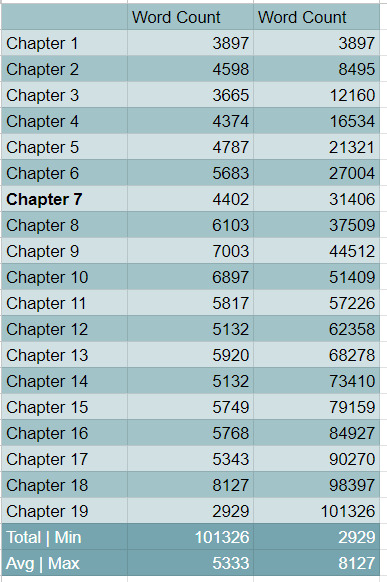
*3/30 Edit to update this chart to its full glory. Column 3 is a cumulative count. Most of what I write breaks 100k and it's fun watching the word count rise until it boils over.
This is the most frustrating to update manually, especially if you don’t have separate docs for each chapter, but it really helps me stay consistent with chapter lengths and the formula for calculating the average and rising totals is super basic.
Not that all your chapters have to be uniform, but if you care about that, this little chart is a fantastic visualizer.
If you have multiple narrators, and this book does, you can also keep track of how many POVs each narrator has, and how spread out they are. I didn’t do that for this book since it’s not an ensemble team and matters less, but I did for my sci-fi WIP, pictured below.

As I was writing that one, I had “scripted” the chapters before going back and writing out all the glorious narrative, and updated the symbols from “scripted” to “finished” accordingly.
I also have a pie chart that I had to make manually on a convoluted iPhone app to color coordinate specifically the way I wanted to easily tell who narrates the most out of the cast, and who needs more representation.
—
Google Docs
Can’t show you much here unfortunately but I’d like to take an aside to talk about my “scene bits” docs.
It’s what it says on the tin, an entire doc all labeled with different heading styles with blurbs for each scene I want to include at some point in the book so I can hop around easily. Whether they make it into the manuscript or not, all practice is good practice and I like to keep old ideas because they might be useful in unsuspecting ways later.
Separate from that, I keep most of my deleted scenes and scene chunks for, again, possible use later in a “deleted scenes” doc, all labeled accordingly.
When I designed my alien language for the sci-fi series, I created a Word doc dictionary and my own "translation" matrix, for easy look-up or word generation whenever I needed it (do y'all want a breakdown for creating foreign languages? It's so fun).
Normally, as with my sci-fi series, I have an entire doc filled with character sheets and important details, I just… didn’t do that for this book. But the point is—you can still make those for free on any word processing software, you don’t need fancy gadgets.
—
I hope this helps anyone struggling! It doesn’t have to be fancy. It doesn’t have to be expensive. Everything I made here, minus the aforementioned timeline and pie chart, was done with basic excel skills and the paint bucket tool. I imagine this can be applicable to games, comics, what have you, it knows no bounds!
Now you have one less excuse to sit down and start writing.
#writing advice#writing resources#writing tips#writing tools#writing a book#writing#writeblr#organizing your book#outlining#shut up and write the book#google sheets#google docs
982 notes
·
View notes
Text
PAC: Why Did You Reincarnate as a Woman?
For this Pick-A-Pile, I am going to continue with my Women’s History Month series, where I uplift, inspire and/or relate to women on this platform. This reading is a bit of a life path reading and a past life reading but it’s more general. So take whatever resonates and leave what doesn’t. Without further ado, please pick a pile!
Left-to-Right (1-3):



Pile 1: If you chose this pile, this is definitely for my girls who like to move around. I think that you’re someone who was meant to be rich, you definitely have expensive taste. In a past life, I think that you were into the esoteric world and into the arts. You dibbled and dabbled in a little bit of this and that. But I don’t think that you were able to find stability in your past life. But you had a clear vision for yourself. So this time, you’ve reincarnated as a woman to gain financial stability and independence from the debts of your past life. In past lives, you could have been non-committal or always wanting to rush into things. And as a result, you reincarnated without ever having a satisfied spirit. As women, we are expected to be the nurturers and sidekicks to men. But you, Pile One, are definitely the main character. You’re a free spirit and a force to be reckoned with. You follow the beat of your own drum. But remember that the goal is to feel happy with where you already are. Your spirit has a lot of fire but don’t burn it out trying to be everywhere all at once. You were born to be the non-comformist and that’s okay.
Signs: Gemini, Taurus, Leo, Sagittarius.
Cards Used: 7 of Cups, 5 of Wands, Queen of Discs, 9 of Discs, 2 of Discs, Ace of Discs, The High Priestess, The Hierophant, 3 of Swords, The Star, 4 of Discs, The World, 8 of Wands and Justice.
extras: beyhive. saweetie. white nails. green eyes. born with heart issues. short-term career path. life path number five. pirates. bohemian style. theatre kid. paint. big city girl.
Pile Two: If you chose this pile, you’re definitely someone who is described as a pure spirit. What’s funny is I channeled those Snapped interviews of people saying their friend was “the light in a dark room”. You have the tendency to make friends easily. You’re very introverted. That’s how it’s supposed to be. In a past life, you could have suffered from depression; perhaps you were in a mental hospital. You were burdened with a reputation that wasn’t true to your character. You were an outcast. Maybe you could predict death & people despised you for it. I think you felt unloved and misunderstood. This life is supposed to be a clean slate for you, Pile Two. I think that there was a lot of gossip about you. But this time, you carried over the scars from being a target of gossip. Maybe you feel like you don’t really have any friends. Maybe you have a weird relationship with trust & you end up trusting the wrong people/none at all. Maybe you keep people at an arms length but you’re still a friend to all. I think that you reincarnated as a woman to reclaim your power and the right to be here on this Earth. You make the world go round, Pile Two. Don’t forget that. Never feel guilty for having fun.
Cards Used: Justice, The Chariot, Knight of Wands, Page of Cups, 3 of Cups, 3 of Discs, King of Wands, 10 of Wands, Queen of Swords, The Magician, Ace of Swords, 9 of Cups, Ace of Cups (RX), Ten of Swords, The High Priestess, 7 of Cups, Queen of Cups and The World (RX).
Signs: Sagittarius, Scorpio, Aquarius, Libra.
extras: nurse. break my soul. ellie goulding. codependency. microsoft. computer geek. smiley emoji. venusian. dmv. pills. fasting. making friends with outcasts. working with autistic children/elderly people.
Pile Three: If you chose this pile, you’re probably a person who struggles with their faith. This doesn’t come from nowhere & it’s not new to you. It’s in fact true to you. Today, you’re described as someone who is rebellious or maybe even lazy, but somehow you never complain about your circumstances. You’re like Trish De La Rosa. You keep a job! But in a past life, you were like a moody teenager. You never really saw the good in things. You were very negative. You held grudges and shunned people if they pissed you off. You could have been a gang member or you were an advocate for civil rights. Either way, your mindset was very black-and-white, no in between. As a result, I feel like you can struggle with following the rules today. I also feel like you have the tendency to be anti-religion/anti-Christianity, which is the basis as to why you struggle with your faith. Someone could have told you that you had “loose” ways as a child and this lit a fire under your ass. Misogyny in the church, but also in general is a reason why you have this fighter spirit. You have a fighter spirit, Pile Three. You’re here as a woman to take back what’s yours. You’re here to help other women realize their worth, reclaim their sexuality and transmute their pain into something beautiful, Pile Three and you will do it successfully.
Cards Used: Nine of Swords, The Star, The Emperor, Ace of Wands (RX), Ten of Swords (RX), Two of Discs, Eight of Cups, Queen of Cups, The Sun (RX), 4 of Discs, The World, 4 of Cups, Justice (RX), 8 of Swords, The Lovers (RX), The Hierophant, Princess of Swords.
Signs: Scorpio, Aries, Capricorn, Pisces.
extras: detention. good luck charlie. rapper. obsessed with cats. megan thee stallion. enough (2002). independent women. scarlet red. queer rights activist.
#law of assumption#manifesting#neville goddard#hoodoo#tarot#tarotreading#astro notes#pick a card#pick a pile#divination#tarotcommunity#tarot deck#pick a reading#pick an image#pac reading#spirituality#tarot pull#tarot pac
493 notes
·
View notes
Text
creatives, please use alt text
one of the first things i learned in journalism school was how to write alt image descriptions.
at first, it felt tedious. every single photo or graphic required a description, and if we skipped it—or wrote a lazy one—our professors didn’t hesitate to fail us. at the time, i didn’t fully understand why it mattered. but now, i’m so grateful they drilled it into us. if i’d never gone to journalism school, i might have never known how vital alt text is.
for those unfamiliar, alt text (short for “alternative text”) is a written description of an image. it allows people who use screen readers to know what’s in an image, making content accessible to those who are blind, visually impaired, or have other disabilities that prevent them from viewing images. you're basically translating visual content into words.
as creatives, whether we’re writers, artists, photographers, or meme page admins, we have a responsibility to make our work accessible. after all, what’s the point of creating something if a huge portion of your audience can’t engage with it?
why alt text matters
it ensures accessibility - a visually impaired person using a screen reader should be able to understand the context of an image just as easily as a sighted person.
it’s inclusive - adding alt text isn’t just for people with disabilities. sometimes, images don’t load due to bad internet, and alt text helps everyone understand what’s missing.
it’s good practice - if your work exists online, you want it to be as widely understood as possible. accessibility makes your content stronger.
okay, but how do i write alt text?
writing alt text isn’t as hard as it might seem! here are some tips:
be concise but descriptive - describe the essential elements of the image. what would someone need to know to get the gist of it?
include context - if the image is part of a larger story, explain its relevance. for example, “a black cat sitting on a pumpkin, used to illustrate a halloween-themed story.”
don’t overthink it - you don’t need to describe every pixel. just focus on the most important details.
alt text and ai tools
in the era of chatgpt and microsoft copilot, we’ve got a major advantage: ai tools can now generate alt text for you!
while these tools aren’t perfect and often need a bit of tweaking, they’re a great starting point. platforms like adobe, microsoft, and even some social media apps have built-in options for generating descriptions. if you’re overwhelmed by the idea of writing alt text from scratch, let ai do the heavy lifting, and then refine it.
a creative responsibility
alt text isn’t just for journalists or big companies, it’s for all of us.
as creatives, we have the power to make the internet a more inclusive place. whether you’re posting a masterpiece, a meme, or a picture of your cat, take a moment to add alt text.
adding alt image description is SO EASY and quick and we all need to get better at adding it to our posts. i, myself, am not perfect. on here, for example, i've been really bad about writing alt image descriptions, and it's something i'm very disappointed in myself for. (i hereby pledge to do better, and please call me out for lacking in the future!)
writing alt text is not only about respecting your audience, but it's also about recognizing disabled people's right to engage with your work.
accessibility isn’t optional !!
#alt text#accessibility#writing#writeblr#journalism#inclusivity#inclusion#altimage#screenreaders#onlinecreativity#writingcommunity#accessible art#art#disability awareness#web accessibility#artists on tumblr#disability rights
138 notes
·
View notes
Text
Gyan Abhishek is standing in front of a giant touch screen, like Jim Cramer on Mad Money or an ESPN talking head analyzing a football play. He’s flicking through a Facebook feed of viral, AI-generated images. “The post you are seeing now is of a poor man that is being used to generate revenue,” he says in Hindi, pointing with his pen to an image of a skeletal elderly man hunched over being eaten by hundreds of bugs. “The Indian audience is very emotional. After seeing photos like this, they Like, Comment and share them. So you too should create a page like this, upload photos and make money through Performance bonus.” He scrolls through the page, titled “Anita Kumari,” which has 112,000 followers and almost exclusively posts images of emaciated, AI-generated people, natural disasters, and starving children. He pauses on another image of a man being eaten by bugs. “They are getting so many likes,” he says. “They got 700 likes within 2-4 hours. They must have earned $100 from just this one photo. Facebook now pays you $100 for 1,000 likes … you must be wondering where you can get these images from. Don’t worry. I’ll show you how to create images with the help of AI.”
[...]
Abhishek has 115,000 YouTube subscribers, dozens of instructional videos, and is part of a community of influencers selling classes and making YouTube content about how to go viral on Facebook with AI-generated images and other types of spam. These influencers act much like financial influencers in the United States, teaching other people how to supposedly spin up a side hustle in order to make money by going viral on Facebook and other platforms. Part of the business model for these influencers is, of course, the fact that they are themselves making money by collecting ad revenue from YouTube and by selling courses and AI prompts on YouTube, WhatsApp and Telegram. Many of these influencers go on each others’ podcasts to discuss strategies, algorithm changes, and loopholes. I have found hundreds of videos about this, many of which have hundreds of thousands or millions of views. But the videos make clear that Facebook’s AI spam problem is one that is powered and funded primarily by Facebook itself, and that most of the bizarre images we have seen over the last year are coming from Microsoft’s AI Image Creator, which is called “Bing Image Creator” in instructional videos.
[...]
The most popular way to make money spamming Facebook is by being paid directly by Facebook to do so via its Creator Bonus Program, which pays people who post viral content. This means that the viral “shrimp Jesus” AI and many of the bizarre things that have become a hallmark of Zombie Facebook have become popular because Meta is directly incentivizing people to post this content.
6 August 2024
171 notes
·
View notes
Text
The Creation of a Physical Copy of Coming Home (But Not to You) - The complete summary
Since, I promised I would update this as soon as I started working on it and boy, has it been several hours of me trying to learn how to use Microsoft word, hundreds of songs in my Jayvik playlist and perhaps, a small minor emotional breakdown. I have gotten Coming Home (But Not to You) formatted for bookbinding.
I hope @lesbianherald knows that they have not only written about 678 pages of a glorious and beautiful story but when in book format, that comes out to be 340 pages which is bigger than Romeo and Juliet by Shakespeare (which.. you out wrote him twice). I swear, I promised to update you and that’s literally all I have besides a minor practice signature before I venture out to find a book suitable to hold the piece and paper that looks a tad more vintage.
The first draft pages in word looked like this, this was also MY final concept before I went out of my way to make a little page design in procreate. (Featured later)
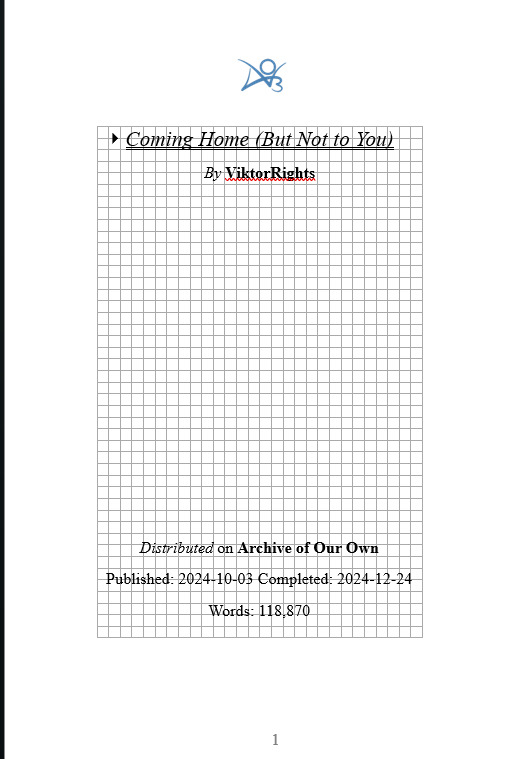

The Artist featured also gave me permission to use this for this personal project. Please, check them out with this link here: X (their art is gorgeous)
[Written January 3rd, 2025]
─── ⋆⋅☼⋅⋆ ───
Okay, we’ve settled on some covers. Might be wondering why I didn’t want to make one from scratch? I didn’t want to weather it, personally. It’s a lot more work and the threading and binding itself is going to take most of my time. I’m working on A4 (Actually, it ended up being smaller than A4 at about 11 by 8.25 but when folded it’s 5.5 by 8.25) paper format, having to adjust my measurements as we go because they were drastically different in the word document. I edited some of the features of the pages and actually sketched out a design for my Cricut to use for the cover and chapter page emblems for just a little personal flare!
I actually went to the thrift store and broke apart books that werent in use to provide me a proper book board because the ones I had were too thick! Reuse and recycle, baby! (All for the power of Jayvik)
A little thing about this project is that I actually bought weathered paper for this! Yeah, that.. it didn’t end up coming LMAO. I did buy some book corners for some metal flare. The hexcore design I drew out, myself, in procreate and also cut out in Cricut (thank you, TikTok tutorials).

A little fact as well; I haven’t bookbinded in 3 years! My books when I started were actually GOD awful— which is also part of why I chose a base book frame because that was my biggest weakness when it came to this. The binding itself was actually the easiest part to me when I started! I kid you not, I did very much come out of retirement because of Jayvik. I wanted a physical book I could mark and leave notes on, so why not make it myself? I’m extremely thankful, I got permission to do this and plan on doing this with another one of my favorite Jayvik fanfictions once it is completed, so perhaps… maybe. I don’t know, after I had gotten all the signatures out I had realized that the book covers used WERE TOO SMALL! This is the book before pressing for over 48 hours and in a middle of a snowstorm!
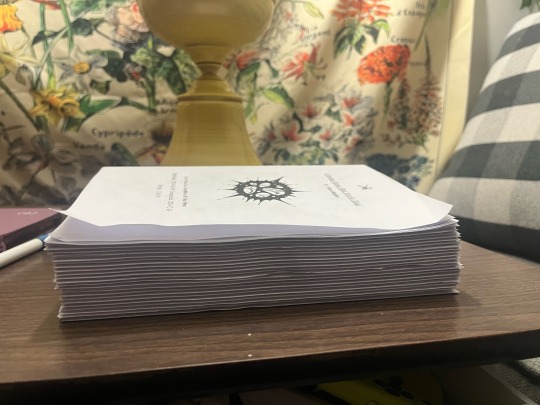
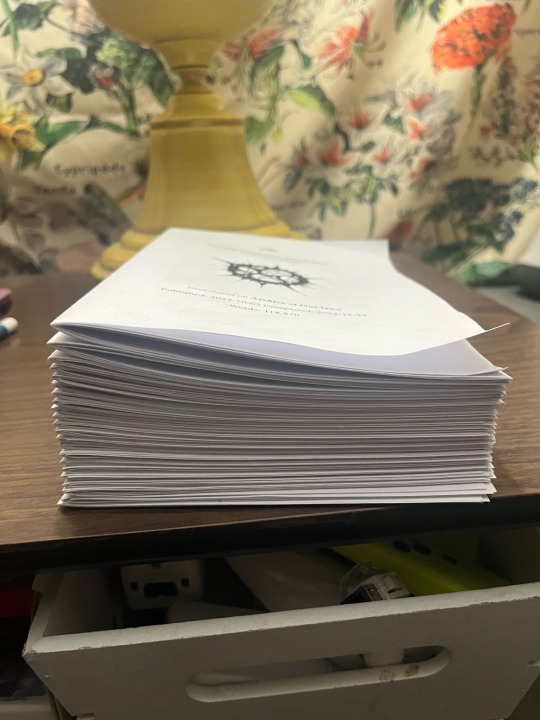
[Written on January 6th, 2025]
─── ⋆⋅☼⋅⋆ ───
And the book is binded! I had used wax thread which is already thicker and way more durable and actually made for bookbinding. It has already had about two layers of glue on the binding but I tend to do about four just for extra strength and protection. It should be going in the book in about a day or two, which will lead to the final update of this!
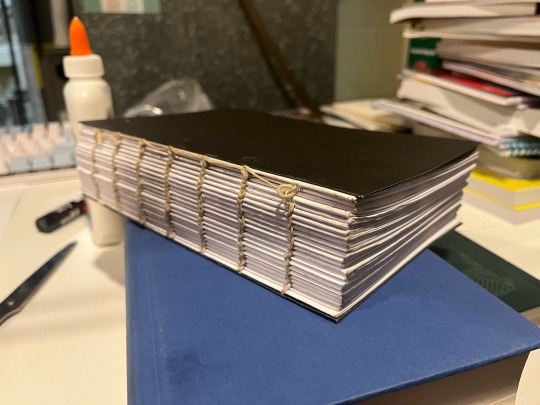
It took me about three well-spread out days, six hours of actual sewing and teaching myself how to use a curved needle without violently stabbing my skin but I was able to get the box-stitch in.. I tried to even out the layers as I had binded too fast in one part and two signatures ended up being uneven, whoops. I fixed that with a tap of a literal hammer (No pun intended) but this was truly an experience. The parts with the open black page on front is when the stitching was glued and the book pages were placed on. This also meant I had the actual book for it to sit in ready. Which was crazy to think about.
Would you believe me if I told you I measured this all by eye and had to cut the pages four different ways to make this book actually become a book. The next paragraphs will be glamor shots. Thank you for sticking with me— encouraging me on this because of my LACK of experience in this entire field and prayers for my poor fingers.
[Written on January 13th, 2025]
─── ⋆⋅☼⋅⋆ ───
And we’re here, it’s finished and settled. Here are the glamor shots. I do plan on doing more bookbinding in the future as I DID enjoy the process but folding and making signatures will forever be my enemy. Here’s the glamor shots and underneath the cut is all my reactions and build up to finishing this monster of a book.


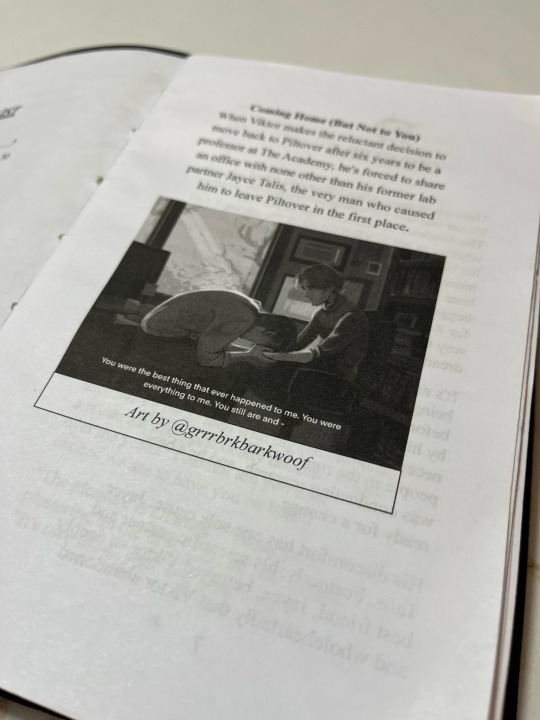

A couple things, I never want to do this again. If I ever do a fanfiction THIS big again. I’m spilting it into two books, perhaps even three depending on how big it is. The symbol on the front is the Piltover symbol, I tried to find Jayce’s Talis house symbol and THERES NOTHING, I literally tried drawing and everything. My Cricut didn’t want to cut it and trust me, I tried for over three hours with the symbol.
What only matters is that I think it’s cute. I think the simplicity and mix of tears added to the final design a lot more than I thought it would.
If I ever do this again. (Knowing me, I will.) I plan on revisiting this, probably make another version when I have more bookbinding knowledge under my belt LMAO, but enjoy this lengthy post. I’m now going to go to bed.
Also huge shout out to my Zelda art book for being my primary book press for this entire thing. I really need a book press.
[Finished, January 14th at 12:08 AM, 2025]
─── ⋆⋅☼⋅⋆ ───
#arcane#jayce talis#jayvik#viktor arcane#league of legends#jayce arcane#I’m actually more dead than a physical flat line#kloof binding#coming home but not to you#CHBNTY
144 notes
·
View notes
Text
The AI hype bubble is the new crypto hype bubble
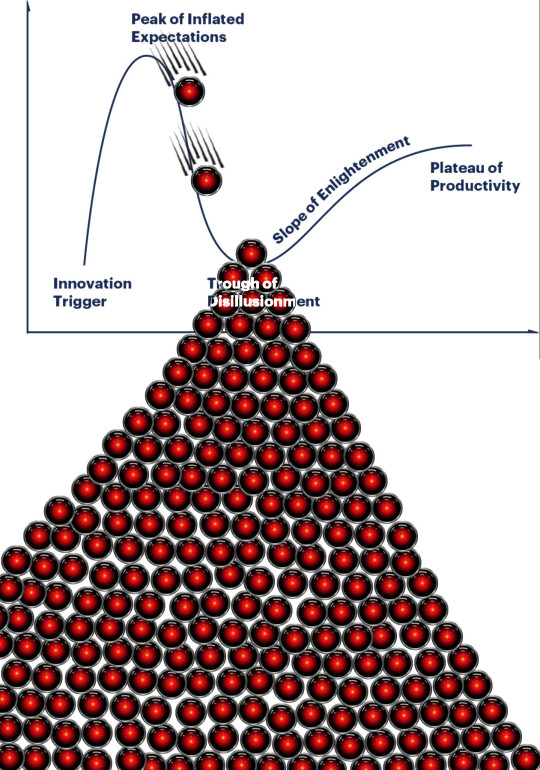
Back in 2017 Long Island Ice Tea — known for its undistinguished, barely drinkable sugar-water — changed its name to “Long Blockchain Corp.” Its shares surged to a peak of 400% over their pre-announcement price. The company announced no specific integrations with any kind of blockchain, nor has it made any such integrations since.
If you’d like an essay-formatted version of this post to read or share, here’s a link to it on pluralistic.net, my surveillance-free, ad-free, tracker-free blog:
https://pluralistic.net/2023/03/09/autocomplete-worshippers/#the-real-ai-was-the-corporations-that-we-fought-along-the-way
LBCC was subsequently delisted from NASDAQ after settling with the SEC over fraudulent investor statements. Today, the company trades over the counter and its market cap is $36m, down from $138m.
https://cointelegraph.com/news/textbook-case-of-crypto-hype-how-iced-tea-company-went-blockchain-and-failed-despite-a-289-percent-stock-rise
The most remarkable thing about this incredibly stupid story is that LBCC wasn’t the peak of the blockchain bubble — rather, it was the start of blockchain’s final pump-and-dump. By the standards of 2022’s blockchain grifters, LBCC was small potatoes, a mere $138m sugar-water grift.
They didn’t have any NFTs, no wash trades, no ICO. They didn’t have a Superbowl ad. They didn’t steal billions from mom-and-pop investors while proclaiming themselves to be “Effective Altruists.” They didn’t channel hundreds of millions to election campaigns through straw donations and other forms of campaing finance frauds. They didn’t even open a crypto-themed hamburger restaurant where you couldn’t buy hamburgers with crypto:
https://robbreport.com/food-drink/dining/bored-hungry-restaurant-no-cryptocurrency-1234694556/
They were amateurs. Their attempt to “make fetch happen” only succeeded for a brief instant. By contrast, the superpredators of the crypto bubble were able to make fetch happen over an improbably long timescale, deploying the most powerful reality distortion fields since Pets.com.
Anything that can’t go on forever will eventually stop. We’re told that trillions of dollars’ worth of crypto has been wiped out over the past year, but these losses are nowhere to be seen in the real economy — because the “wealth” that was wiped out by the crypto bubble’s bursting never existed in the first place.
Like any Ponzi scheme, crypto was a way to separate normies from their savings through the pretense that they were “investing” in a vast enterprise — but the only real money (“fiat” in cryptospeak) in the system was the hardscrabble retirement savings of working people, which the bubble’s energetic inflaters swapped for illiquid, worthless shitcoins.
We’ve stopped believing in the illusory billions. Sam Bankman-Fried is under house arrest. But the people who gave him money — and the nimbler Ponzi artists who evaded arrest — are looking for new scams to separate the marks from their money.
Take Morganstanley, who spent 2021 and 2022 hyping cryptocurrency as a massive growth opportunity:
https://cointelegraph.com/news/morgan-stanley-launches-cryptocurrency-research-team
Today, Morganstanley wants you to know that AI is a $6 trillion opportunity.
They’re not alone. The CEOs of Endeavor, Buzzfeed, Microsoft, Spotify, Youtube, Snap, Sports Illustrated, and CAA are all out there, pumping up the AI bubble with every hour that god sends, declaring that the future is AI.
https://www.hollywoodreporter.com/business/business-news/wall-street-ai-stock-price-1235343279/
Google and Bing are locked in an arms-race to see whose search engine can attain the speediest, most profound enshittification via chatbot, replacing links to web-pages with florid paragraphs composed by fully automated, supremely confident liars:
https://pluralistic.net/2023/02/16/tweedledumber/#easily-spooked
Blockchain was a solution in search of a problem. So is AI. Yes, Buzzfeed will be able to reduce its wage-bill by automating its personality quiz vertical, and Spotify’s “AI DJ” will produce slightly less terrible playlists (at least, to the extent that Spotify doesn’t put its thumb on the scales by inserting tracks into the playlists whose only fitness factor is that someone paid to boost them).
But even if you add all of this up, double it, square it, and add a billion dollar confidence interval, it still doesn’t add up to what Bank Of America analysts called “a defining moment — like the internet in the ’90s.” For one thing, the most exciting part of the “internet in the ‘90s” was that it had incredibly low barriers to entry and wasn’t dominated by large companies — indeed, it had them running scared.
The AI bubble, by contrast, is being inflated by massive incumbents, whose excitement boils down to “This will let the biggest companies get much, much bigger and the rest of you can go fuck yourselves.” Some revolution.
AI has all the hallmarks of a classic pump-and-dump, starting with terminology. AI isn’t “artificial” and it’s not “intelligent.” “Machine learning” doesn’t learn. On this week’s Trashfuture podcast, they made an excellent (and profane and hilarious) case that ChatGPT is best understood as a sophisticated form of autocomplete — not our new robot overlord.
https://open.spotify.com/episode/4NHKMZZNKi0w9mOhPYIL4T
We all know that autocomplete is a decidedly mixed blessing. Like all statistical inference tools, autocomplete is profoundly conservative — it wants you to do the same thing tomorrow as you did yesterday (that’s why “sophisticated” ad retargeting ads show you ads for shoes in response to your search for shoes). If the word you type after “hey” is usually “hon” then the next time you type “hey,” autocomplete will be ready to fill in your typical following word — even if this time you want to type “hey stop texting me you freak”:
https://blog.lareviewofbooks.org/provocations/neophobic-conservative-ai-overlords-want-everything-stay/
And when autocomplete encounters a new input — when you try to type something you’ve never typed before — it tries to get you to finish your sentence with the statistically median thing that everyone would type next, on average. Usually that produces something utterly bland, but sometimes the results can be hilarious. Back in 2018, I started to text our babysitter with “hey are you free to sit” only to have Android finish the sentence with “on my face” (not something I’d ever typed!):
https://mashable.com/article/android-predictive-text-sit-on-my-face
Modern autocomplete can produce long passages of text in response to prompts, but it is every bit as unreliable as 2018 Android SMS autocomplete, as Alexander Hanff discovered when ChatGPT informed him that he was dead, even generating a plausible URL for a link to a nonexistent obit in The Guardian:
https://www.theregister.com/2023/03/02/chatgpt_considered_harmful/
Of course, the carnival barkers of the AI pump-and-dump insist that this is all a feature, not a bug. If autocomplete says stupid, wrong things with total confidence, that’s because “AI” is becoming more human, because humans also say stupid, wrong things with total confidence.
Exhibit A is the billionaire AI grifter Sam Altman, CEO if OpenAI — a company whose products are not open, nor are they artificial, nor are they intelligent. Altman celebrated the release of ChatGPT by tweeting “i am a stochastic parrot, and so r u.”
https://twitter.com/sama/status/1599471830255177728
This was a dig at the “stochastic parrots” paper, a comprehensive, measured roundup of criticisms of AI that led Google to fire Timnit Gebru, a respected AI researcher, for having the audacity to point out the Emperor’s New Clothes:
https://www.technologyreview.com/2020/12/04/1013294/google-ai-ethics-research-paper-forced-out-timnit-gebru/
Gebru’s co-author on the Parrots paper was Emily M Bender, a computational linguistics specialist at UW, who is one of the best-informed and most damning critics of AI hype. You can get a good sense of her position from Elizabeth Weil’s New York Magazine profile:
https://nymag.com/intelligencer/article/ai-artificial-intelligence-chatbots-emily-m-bender.html
Bender has made many important scholarly contributions to her field, but she is also famous for her rules of thumb, which caution her fellow scientists not to get high on their own supply:
Please do not conflate word form and meaning
Mind your own credulity
As Bender says, we’ve made “machines that can mindlessly generate text, but we haven’t learned how to stop imagining the mind behind it.” One potential tonic against this fallacy is to follow an Italian MP’s suggestion and replace “AI” with “SALAMI” (“Systematic Approaches to Learning Algorithms and Machine Inferences”). It’s a lot easier to keep a clear head when someone asks you, “Is this SALAMI intelligent? Can this SALAMI write a novel? Does this SALAMI deserve human rights?”
Bender’s most famous contribution is the “stochastic parrot,” a construct that “just probabilistically spits out words.” AI bros like Altman love the stochastic parrot, and are hellbent on reducing human beings to stochastic parrots, which will allow them to declare that their chatbots have feature-parity with human beings.
At the same time, Altman and Co are strangely afraid of their creations. It’s possible that this is just a shuck: “I have made something so powerful that it could destroy humanity! Luckily, I am a wise steward of this thing, so it’s fine. But boy, it sure is powerful!”
They’ve been playing this game for a long time. People like Elon Musk (an investor in OpenAI, who is hoping to convince the EU Commission and FTC that he can fire all of Twitter’s human moderators and replace them with chatbots without violating EU law or the FTC’s consent decree) keep warning us that AI will destroy us unless we tame it.
There’s a lot of credulous repetition of these claims, and not just by AI’s boosters. AI critics are also prone to engaging in what Lee Vinsel calls criti-hype: criticizing something by repeating its boosters’ claims without interrogating them to see if they’re true:
https://sts-news.medium.com/youre-doing-it-wrong-notes-on-criticism-and-technology-hype-18b08b4307e5
There are better ways to respond to Elon Musk warning us that AIs will emulsify the planet and use human beings for food than to shout, “Look at how irresponsible this wizard is being! He made a Frankenstein’s Monster that will kill us all!” Like, we could point out that of all the things Elon Musk is profoundly wrong about, he is most wrong about the philosophical meaning of Wachowksi movies:
https://www.theguardian.com/film/2020/may/18/lilly-wachowski-ivana-trump-elon-musk-twitter-red-pill-the-matrix-tweets
But even if we take the bros at their word when they proclaim themselves to be terrified of “existential risk” from AI, we can find better explanations by seeking out other phenomena that might be triggering their dread. As Charlie Stross points out, corporations are Slow AIs, autonomous artificial lifeforms that consistently do the wrong thing even when the people who nominally run them try to steer them in better directions:
https://media.ccc.de/v/34c3-9270-dude_you_broke_the_future
Imagine the existential horror of a ultra-rich manbaby who nominally leads a company, but can’t get it to follow: “everyone thinks I’m in charge, but I’m actually being driven by the Slow AI, serving as its sock puppet on some days, its golem on others.”
Ted Chiang nailed this back in 2017 (the same year of the Long Island Blockchain Company):
There’s a saying, popularized by Fredric Jameson, that it’s easier to imagine the end of the world than to imagine the end of capitalism. It’s no surprise that Silicon Valley capitalists don’t want to think about capitalism ending. What’s unexpected is that the way they envision the world ending is through a form of unchecked capitalism, disguised as a superintelligent AI. They have unconsciously created a devil in their own image, a boogeyman whose excesses are precisely their own.
https://www.buzzfeednews.com/article/tedchiang/the-real-danger-to-civilization-isnt-ai-its-runaway
Chiang is still writing some of the best critical work on “AI.” His February article in the New Yorker, “ChatGPT Is a Blurry JPEG of the Web,” was an instant classic:
[AI] hallucinations are compression artifacts, but — like the incorrect labels generated by the Xerox photocopier — they are plausible enough that identifying them requires comparing them against the originals, which in this case means either the Web or our own knowledge of the world.
https://www.newyorker.com/tech/annals-of-technology/chatgpt-is-a-blurry-jpeg-of-the-web
“AI” is practically purpose-built for inflating another hype-bubble, excelling as it does at producing party-tricks — plausible essays, weird images, voice impersonations. But as Princeton’s Matthew Salganik writes, there’s a world of difference between “cool” and “tool”:
https://freedom-to-tinker.com/2023/03/08/can-chatgpt-and-its-successors-go-from-cool-to-tool/
Nature can claim “conversational AI is a game-changer for science” but “there is a huge gap between writing funny instructions for removing food from home electronics and doing scientific research.” Salganik tried to get ChatGPT to help him with the most banal of scholarly tasks — aiding him in peer reviewing a colleague’s paper. The result? “ChatGPT didn’t help me do peer review at all; not one little bit.”
The criti-hype isn’t limited to ChatGPT, of course — there’s plenty of (justifiable) concern about image and voice generators and their impact on creative labor markets, but that concern is often expressed in ways that amplify the self-serving claims of the companies hoping to inflate the hype machine.
One of the best critical responses to the question of image- and voice-generators comes from Kirby Ferguson, whose final Everything Is a Remix video is a superb, visually stunning, brilliantly argued critique of these systems:
https://www.youtube.com/watch?v=rswxcDyotXA
One area where Ferguson shines is in thinking through the copyright question — is there any right to decide who can study the art you make? Except in some edge cases, these systems don’t store copies of the images they analyze, nor do they reproduce them:
https://pluralistic.net/2023/02/09/ai-monkeys-paw/#bullied-schoolkids
For creators, the important material question raised by these systems is economic, not creative: will our bosses use them to erode our wages? That is a very important question, and as far as our bosses are concerned, the answer is a resounding yes.
Markets value automation primarily because automation allows capitalists to pay workers less. The textile factory owners who purchased automatic looms weren’t interested in giving their workers raises and shorting working days. ‘ They wanted to fire their skilled workers and replace them with small children kidnapped out of orphanages and indentured for a decade, starved and beaten and forced to work, even after they were mangled by the machines. Fun fact: Oliver Twist was based on the bestselling memoir of Robert Blincoe, a child who survived his decade of forced labor:
https://www.gutenberg.org/files/59127/59127-h/59127-h.htm
Today, voice actors sitting down to record for games companies are forced to begin each session with “My name is ______ and I hereby grant irrevocable permission to train an AI with my voice and use it any way you see fit.”
https://www.vice.com/en/article/5d37za/voice-actors-sign-away-rights-to-artificial-intelligence
Let’s be clear here: there is — at present — no firmly established copyright over voiceprints. The “right” that voice actors are signing away as a non-negotiable condition of doing their jobs for giant, powerful monopolists doesn’t even exist. When a corporation makes a worker surrender this right, they are betting that this right will be created later in the name of “artists’ rights” — and that they will then be able to harvest this right and use it to fire the artists who fought so hard for it.
There are other approaches to this. We could support the US Copyright Office’s position that machine-generated works are not works of human creative authorship and are thus not eligible for copyright — so if corporations wanted to control their products, they’d have to hire humans to make them:
https://www.theverge.com/2022/2/21/22944335/us-copyright-office-reject-ai-generated-art-recent-entrance-to-paradise
Or we could create collective rights that belong to all artists and can’t be signed away to a corporation. That’s how the right to record other musicians’ songs work — and it’s why Taylor Swift was able to re-record the masters that were sold out from under her by evil private-equity bros::
https://doctorow.medium.com/united-we-stand-61e16ec707e2
Whatever we do as creative workers and as humans entitled to a decent life, we can’t afford drink the Blockchain Iced Tea. That means that we have to be technically competent, to understand how the stochastic parrot works, and to make sure our criticism doesn’t just repeat the marketing copy of the latest pump-and-dump.
Today (Mar 9), you can catch me in person in Austin at the UT School of Design and Creative Technologies, and remotely at U Manitoba’s Ethics of Emerging Tech Lecture.
Tomorrow (Mar 10), Rebecca Giblin and I kick off the SXSW reading series.
Image: Cryteria (modified) https://commons.wikimedia.org/wiki/File:HAL9000.svg
CC BY 3.0 https://creativecommons.org/licenses/by/3.0/deed.en
[Image ID: A graph depicting the Gartner hype cycle. A pair of HAL 9000's glowing red eyes are chasing each other down the slope from the Peak of Inflated Expectations to join another one that is at rest in the Trough of Disillusionment. It, in turn, sits atop a vast cairn of HAL 9000 eyes that are piled in a rough pyramid that extends below the graph to a distance of several times its height.]
#pluralistic#ai#ml#machine learning#artificial intelligence#chatbot#chatgpt#cryptocurrency#gartner hype cycle#hype cycle#trough of disillusionment#crypto#bubbles#bubblenomics#criti-hype#lee vinsel#slow ai#timnit gebru#emily bender#paperclip maximizers#enshittification#immortal colony organisms#blurry jpegs#charlie stross#ted chiang
2K notes
·
View notes
Text
Let’s face it, building a website can be far too complex for the ordinary person. Thanks to the low-code and no-code revolution, organizations have become equipped to respond to and adapt to rapidly changing business situations swiftly.
Low-code and no-code software development tools gained popularity, particularly for internal tool development within organizations. According to leading research and advisory company Gartner, using low-code or no-code technologies will increase significantly in the coming years. By 2025, it is estimated that 70% of new enterprise applications will be developed using these technologies, up from less than 25% in 2020.
One such tool gaining strides in the market is Microsoft’s Power Pages (formerly known as Power Apps Portal). This innovative platform offers businesses an easy and efficient way to create public-facing websites without requiring extensive technical skills. In this blog post, we’ll explore how you can build your website using Microsoft capabilities and take a closer look at the new and planned features of Power Pages that make it an exciting option for businesses of all sizes. From low-code development to seamless integration with Microsoft 365 ecosystem, we’ll cover everything you need to know about creating stunning websites with Power Pages. Let’s dive in!
1 note
·
View note
Text





🎄💾🗓️ Day 7: Retrocomputing Advent Calendar - Altair 8800🎄💾🗓️
The Altair 8800 was one of the first commercially successful personal computers, introduced in 1975 by MITS, and also one of the most memorable devices in computing history. Powered by the Intel 8080 CPU, an 8-bit processor running at 2 MHz, and initially came with 256 bytes of RAM, expandable via its S-100 bus architecture. Users would mainly interact with the Altair through its front panel-mounted toggle switches for input and LEDs for output.
The Altair 8800 was popularized through a Popular Electronics magazine article, as a kit for hobbyists to build.
It was inexpensive and could be expanded, creating a following of enthusiasts that launched the personal computer market. Specifically, it motivated software development, such as Microsoft's first product, Altair BASIC.
The Altair moved from hobbyist kits to consumer-ready personal computers because of its modular design, reliance on the S-100 bus that eventually became an industry standard, and the rise of user groups like the Homebrew Computer Club.
Many of ya'll out there mentioned the Altair 8800, be sure to share your stories! And check out more history of the Altair on its Wikipedia page -
along with the National Museum of American History - Behring center -
Have first computer memories? Post’em up in the comments, or post yours on socialz’ and tag them #firstcomputer #retrocomputing – See you back here tomorrow!
#retrocomputing#altair8800#firstcomputer#electronics#vintagecomputing#computinghistory#8080processor#s100bus#microsoftbasic#homebrewcomputerclub#1975tech#personalcomputers#computerkits#ledswitches#technostalgia#oldschooltech#intel8080#computerscience#techenthusiasts#diycomputing#earlycomputers#computermemory#vintageelectronics#hobbycomputing#popularelectronics#techhistory#innovation#computermilestones#geekculture
45 notes
·
View notes
Text
#Dynamics 365 portal#Dynamics partner portal#microsoft portals#microsoft dynamics portal#microsoft power pages#microsoft power portal#power pages#power pages microsoft#power pages power bi#power pages sharepoint
1 note
·
View note
Text
Why don't people ride public transit more often? There are many excuses provided, but I think the big one is ownership. When someone else owns the bus, it is hard to feel pride about it. Someone else takes it to the mechanic. Someone else washes it. Someone else waits for a tow truck when they climb on the throttle a little too hard on the interstate and blow up the injection pump.
Wait, I hear you say, surely everyone owns the bus? Every single taxpayer owns a fractional share of the public transit infrastructure, so everyone can be proud of what we made as a group. You're certainly right, but nobody is proud of the power lines, or all the pee we clean up before it hits the river. Shareholding isn't thing-holding: just ask all the folks who own a teeny tiny bit of Microsoft, but can't point to the specific chunk of the building they're responsible for. We're weird that way, us apes.
Don't worry. Like I told my first boss, I don't like to bring problems to you, only solutions. Have you ever been by one of those charity things where you can get your name on a brick, or a bench, if you donate? I think they should do the same thing about buses. Nobody stirs the imagination about ol' #7345, even if it does have a page all to itself on the transit-aficionados wiki. If it has a name – a real citizen, just like you! – things are different. What is their life like? Maybe they're riding on this bus, in secret? They could be any of these people. An instant celebrity, immortalized by some letters painted on the side of a white box with wheels.
Sure, there are some gaps in this plan. Some people won't want to have their names associated with a bus, because their lives are terrible and sad and very small. We don't really have enough buses to give each contributor one. And some will get downright weird about it, demanding to ride only on "their" bus.
I, too, have a solution for this: make all the buses much smaller, roughly Power Wheels-sized, and have them seat only one person at a time. Then we'll just put them on a big track, like at bumper cars, and let everyone go hog wild on each other on their way to work. I just so happen to have recently taken delivery of a large quantity of bumper cars from a reputable former amusement park...
140 notes
·
View notes
Text
A week and a half ago, Goldman Sachs put out a 31-page-report (titled "Gen AI: Too Much Spend, Too Little Benefit?”) that includes some of the most damning literature on generative AI I've ever seen. And yes, that sound you hear is the slow deflation of the bubble I've been warning you about since March. The report covers AI's productivity benefits (which Goldman remarks are likely limited), AI's returns (which are likely to be significantly more limited than anticipated), and AI's power demands (which are likely so significant that utility companies will have to spend nearly 40% more in the next three years to keep up with the demand from hyperscalers like Google and Microsoft). ... I feel a little crazy every time I write one of these pieces, because it's patently ridiculous. Generative AI is unprofitable, unsustainable, and fundamentally limited in what it can do thanks to the fact that it's probabilistically generating an answer. It's been eighteen months since this bubble inflated, and since then very little has actually happened involving technology doing new stuff, just an iterative exploration of the very clear limits of what an AI model that generates answers can produce, with the answer being "something that is, at times, sort of good." It's obvious. It's well-documented. Generative AI costs far too much, isn't getting cheaper, uses too much power, and doesn't do enough to justify its existence. There are no killer apps, and no killer apps on the horizon. And there are no answers.
96 notes
·
View notes